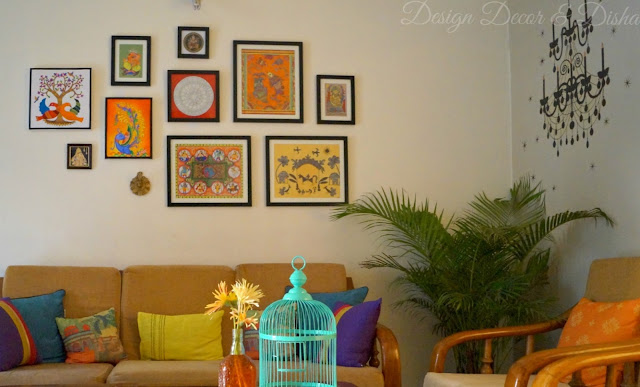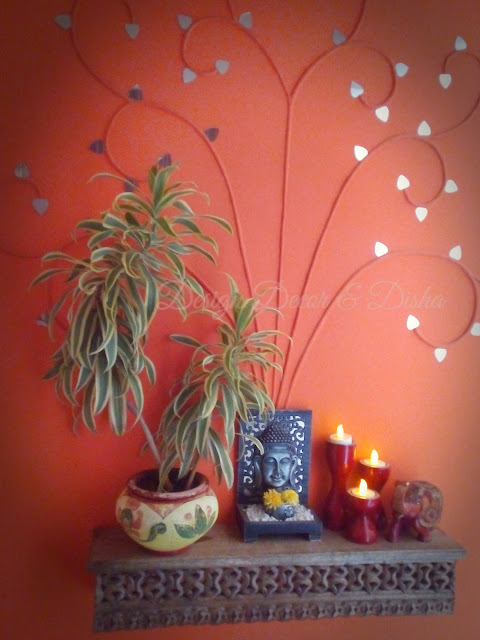I have been growing plants since childhood, thanks to my mom who has always been my inspiration. I wouldn't say I've mastered the art of growing all types of plants but I've gained enough confidence and a little bit knowledge to grow them indoors as well as outdoors without killing them. And today I'm sharing what are the best indoor plants that are easy to grow and how to care for them. You can
The question then arises, "Why to grow indoor plants"!!
Let me share my experience. Grow indoor plants to bring nature inside your home. Houseplants can perk up any dull space instantly by adding cheer and liveliness. One more reason to grow indoor plants is that houseplants purify the air by removing toxins like benzene, formaldehyde, toluene and xylene that are the dangerous molecules to inhale and by increasing humidity. Indoor plants create a relaxing and calming environment. The last but not the least, growing indoor plants can be a satisfying and rewarding experience. You can share your experiences in comments below. I would be happy to know!
In India, we have a variety of climatic zones from tropical to temperate and alpine. Depending on the climatic zone of your region you should select the plants and care for them accordingly. Plants that are native to that particular region grow best without putting extra efforts. But if you want to grow a variety of plants then there are certain things to keep in mind as a rule of thumb and they are; well-draining soil, right amount of sunlight (which should be bright indirect sunlight or maybe artificial light) and right amount of water and feeding your plants time to time with a good fertilizer. Below are some best indoor plants and I have added details of their light, water and food requirements. In my view, you can grow any plant as an indoor plant but then remember that you should keep it in sun everyday or every alternate day for 2-3 hrs.
1. Pothos/ Money Plant:
Grow it in water or soil, whether it is climbing or cascading, pothos never fails to add cheer to your indoors. It comes in a range of leaf shades from green to golden and variegated. Grow it in well draining soil. Money plant is quite a hardy plant and can do well in bright as well as low light, Watering is the most important thing to keep it alive. Water it only when the 1-2" of soil appears dry. Overwatering will rot the roots and the leaves will turn yellow. Whereas if the leaves are wilting and turning brown then know that you are watering it less. Fertilize it with 20-20-20 fertilizer once in a month. Pothos cleans the air in the room.
Toxicity: Pothos is toxic to humans and pets (when ingested).
2. Areca Palm:
Areca palm is the most common and beautiful indoor plant with feathery fronds. Keep it indoors to give a tropical feel to your living room. It loves moist soil and indirect or filtered sunlight. Bright sunlight may burn its leaves. Being a tropical plant it enjoys high humidity so water it regularly to keep the soil moist in summers and in winters allow the 1-2" of the soil surface to dry. Pot it in a fairly large pot so that it grows well and repot it after every 2-3 years. Fertilize it monthly with balanced liquid fertilizer in summers. Areca palm is an air purifier and cleans the toxin from the air.
Toxicity: Areca Plam is not a toxic plant.
3. Spider Plant:
Spider plant or chlorophytum comosum is the easiest to grow houseplant. This is an excellent plant for those who have a brown thumb and wish to start an indoor garden. Like other indoor plants, plant it in well-draining soil. Place it where it receives bright indirect sunlight. Keep the soil moist in summers and allow it to dry a bit in winters. Spider plant looks lovely in hanging baskets. It can easily be propagated by planting the spiderettes that grow from the main plant. Spider plant is also a good air purifier and can be kept in bedroom as well.
Toxicity: Spider plant is non-toxic to pets.
4. Song Of India/ Dracaena Reflexa:
Song of India or dracaena Reflexa is the most popular, easiest to grow and very low maintenance plant. Keep the bit dried. It loves less water and diffused sunlight. It grows well in a warm climate but excess sunlight can burn the leaves. Overwatering or moist soil will cause the root rot and plant will die. So always allow the soil to dry between watering. Song of India can be propagated easily from cuttings. This houseplant also purifies the air.
Toxicity: It is slightly toxic to pets.
5. Croton & Coleus:
Croton and coleus plants are often grown outdoors but can be grown indoors as well. They come in a range of leaf colors and shapes. Their amazing colors make them an excellent indoor plant. Like Areca Palm, Croton & Coleus are tropical plants and love humidity. So keep the soil moist constantly. Since these are tropical plants they enjoy bright light so place them near a window. Fertilize them every 2-3 weeks. Croton & Coleus can be propagated by stem cuttings.
Toxicity: Croton is toxic to humans and pets.
6. Arrowhead/ Syngonium:
Arrowhead, American evergreen, Elephant ear plant and butterfly plant are some common name of Syngonium. I love this plant for its fuller look and low maintenance. It is also a tropical plant and loves bright light and high humidity but do not keep it in direct sunlight as it will turn the leaves brown. Keep the soil moist in summers and in winters water only when the soil appears dry. Feed the plant 2-3 times in a month.
Toxicity: Arrowhead is a poisonous plant
6. Arrowhead/ Syngonium:
Toxicity: Arrowhead is a poisonous plant
7. Snake Plant/ Mother-in-law's Tongue:
Oh! what a funny name it has got, isn't it!! But contrary to its name it is the beautiful and really a very good plant. This plant is tolerant of a variety of light conditions but prefers to be in indirect sunlight. Water it less because it doesn't love overwatering also, don't water the leaves while watering. A small amount of fertilizer during summers is all that it needs. It is known to be a great bedroom plant because unlike other plants it gives off oxygen at night. It also cleans the air by removing harmful molecules of xylene, toluene, formaldehyde and benzene.
Toxicity: Snake plant is toxic to humans and pets.
8. Shamrock Plant/ Oxalis Triangularis:
Toxicity: Snake plant is toxic to humans and pets.
8. Shamrock Plant/ Oxalis Triangularis:
Shamrock plant or Oxalis comes in a variety of shade from purple to green, orange to yellow. It is an attractive plant because of its clover-shaped leaves which folds up at night and opens up during the daytime. Purple Shamrock is called oxalis triangularis which grows pink flowers and has beautiful purple leaves. I have a green variety called Oxalis Stricta which is a rampaging weed but I love its leaves and delicate flowers so I love to grow it as an indoor plant. Shamrock plant enjoys sunny spot so keep it near the window. It can be grown well in a compact pot. It goes dormant in summers. Do not over water Purple Shamrock. Always allow the soil to dry between watering. Fertilize it once in a month in growing season.
Toxicity: Oxalis is a slightly toxic indoor plant.
Toxicity: Oxalis is a slightly toxic indoor plant.
9. Aloe Vera:
Aloe Vera (Ghrutkumari or Gwarpatha in Hindi) makes a wonderful houseplant. It is a succulent and stores water in its leaves so do not over water. It can go a long time without water which makes it a fuss-free plant. Make sure the pot has enough draining holes so that water doesn't accumulate inside the pot and cause the roots to rot. Aloe Vera loves bright light so ideal spot to keep it would be near a window. You don't require to feed Aloe Vera with fertilizer. It can be propagated by division. Remove the offsets or babies from the mother plant and plant them in a different pot.
Toxicity: Though it has medicinal uses but the outer skin of it when ingested can be harmful as it is slightly toxic.
Some more houseplants are Boston Fern, Dumbcane, Peacelily, Philodendron, zeezee plant, arelia, Bamboo Plant and some more succulents. You can find a complete blog on indoor succulent garden here. This brings me to the end and I really hope that this blog and video help you to create your own wonderful indoor jungle.
#IndianDecorBlog #IndianDecorBlogger #IndianGardening #Gardening #IndoorPlants #Houseplants
















0 komentar